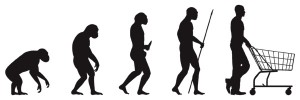retail evolution
In just the past week, I’ve had several conversations about the future of retail – and how drastically shopping as we’ve known it is going to change. From these provocative discussions, it’s become clear to me that retailers must change the way think about and build their brands, or face extinction.
Some of the observations about retail from our conversations include:
- The role of the physical store has changed. They’re no longer distribution centers — instead, they’re experience and service providers.
- “Going shopping” is being replaced by “shopping moments.” Shopping is no longer only a discrete, planned activity – it’s something that often happens throughout a person’s normal course of a going through the day.
- Those retailers which offer truly integrated multi-channel shopping are the ones that are growing.
- The value of department stores and shopping malls is declining, since online players fulfill the desire for multiple product lines and brands in a single “location” more effectively than physical retailers.
- Wallets are becoming as unnecessary as watches. Smart phones are easier to use, provide more functionality, and offer greater security.
Several data points speak to these changes:
- Tesco’s Homeplus — The company erected billboards on a subway platform in Korea that allow customers to shop using QR codes. When the online purchase is done, the goods are delivered to their door once they get home.
- Growth in Airport retail – Stephanie Clifford recently reported in the New York Times about the growing number and diversity of retailers opening stores in airports.
- Progressive Insurance – Viewers can now “Shazam” their ads: While watching a Progressive ad, viewers can use the mobile app to receive an auto insurance quote and interact with the brand in fun ways, like downloading custom wallpaper onto their device.
These changes have broad and significant implications for retailers’ operating models, technological capabilities, and growth strategies. There are also serious implications for retailers’ brands. A few different brand-building requirements for retailers come to mind:
1. creating awareness and staying top of mind. No longer can retailers rely on good advertising placement and real estate selection to get and stay on people’s radar screens. With growing “on demand” shopping, retailers must be in the right places at the right times.
That requires knowing your customers’ lifestyles and behavior patterns to such a degree that you can anticipate when shopping moments are likely to occur – and even perhaps prompt them. Anthropologically-based consumer research methods are critical to developing this level of customer intimacy.
2. fulfilling orders. Retailers must create a great experience at the “second moment of truth.” The “first moment of truth,” a concept popularized by P&G’s former CMO Jim Stengel, refers to the instant when a shopper encounters a product on the shelf — and suggests that the final moment of truth refers to when the person actually uses the product.
Now, in between these two moments of truth lies another one – the fulfillment moment, when people take possession of their purchases. With ordering products through mobile and Internet, this moment happens through shipment and delivery to the shoppers’ home or business. (I also believe there is a growing demand for retail stores to offer delivery.)
The speed and security of shipment and delivery, as well as the way the shipping package looks and feels when it arrives, are moments of truth for the brand. They have an impact on brand perceptions, and as such, need to be designed and executed as carefully as advertising, packaging, and point of purchase materials in traditional retail.
3. using brand signals. Retailers can control the physical environment in store and the virtual one online and in mobile. But when shopping happens in environments out of the retailers’ control, they still must consider how to use brand signals to create a distinctive and memorable brand experience.
As increased accessibility leads customers to emphasize convenience and price, there is the risk that they become brand-agnostic. So the consistent or prominent use of a logo or visuals in the shopping environment is not enough to make a brand impact. Retailers should think about how other senses can be engaged and experiment with multi-sensory cues (think music, tactility, and smell).
I’m sure the retail landscape and shopping behavior will continue to evolve – and the implications on brand-building will as well. But clearly it’s about survival of the fittest.
(This post was inspired primarily by conversations with several clients and as well as two of my partners: David Murphy and Shawn Parr – fine men and smart brand builders. Thanks, guys!)
related posts:
